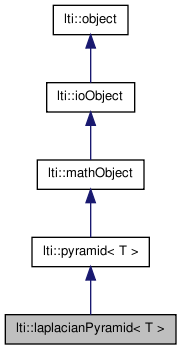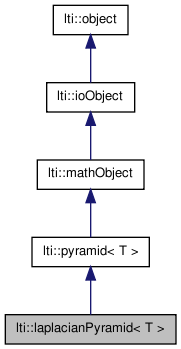lti::laplacianPyramid< T > Class Template Reference
LaplacianPyramid class.
More...
#include <ltiLaplacianPyramid.h>
List of all members.
Public Member Functions |
| | laplacianPyramid (const int &resolutions=0, const int &gaussianSize=3, const double &variance=-1) |
| | laplacianPyramid (const laplacianPyramid &other) |
| virtual | ~laplacianPyramid () |
| void | getKernelParameters (int &size, double &variance) const |
| void | setKernelParameters (const int &size, const double &variance=-1) |
| const char * | getTypeName () const |
| laplacianPyramid< T > & | copy (const laplacianPyramid< T > &other) |
| virtual mathObject * | clone () const |
| void | generate (const T &src) |
| void | generate (const T &src, const int &theResolutions) |
| void | generate (const T &src, const lti::point &limit) |
| void | generate (const gaussianPyramid< T > &src) |
| T & | reconstruct (const int &i, T &result) const |
| pyramid< T > & | reconstruct (const int &i, pyramid< T > &result) const |
Protected Member Functions |
| void | subtract (const T &a, const T &b, T &c) const |
| void | add (const T &a, const T &b, T &c) const |
Protected Attributes |
| int | kernelSize |
| double | kernelVariance |
Detailed Description
template<class T>
class lti::laplacianPyramid< T >
LaplacianPyramid class.
This class implements the Laplacian pyramids as described in Greenspan et.at. "Overcomplete Steerable Pyramid Filters and
Rotation Invariance", Proc. of the IEEE Conf. on Computer Vision and Pattern Recognition, Seattle, 1994
Each level corresponds to a difference of Gaussians, where the level distance is always one octave.
It allows an easy manipulation of the different resolutions.
See method generate() to an detailed explanation
Constructor & Destructor Documentation
create a laplacian pyramid with the given number of resolutions
- Parameters:
-
| resolutions | the number of resolutions that the pyramid can hold (default 0: an empty pyramid will be created) |
| gaussianSize | the size of the laplacian kernel (default 3) |
| variance | the variance of the laplacian kernel (default -1, meaning that the variance should be calculated as described in the lti::gaussKernel1D<T>) |
Member Function Documentation
add a and b, and leave the result in c, which will have the size of a, even if the sizes of a and b differ.
assigment operator.
copy the contents of other in this object.
- Parameters:
-
- Returns:
- a reference to this object
Reimplemented from lti::pyramid< T >.
generate the laplacian pyramid of the given object.
Proceed, until given limit.x or limit.y is reached. smallest resolution will be > limit.
The resolution "0" corresponds to the original channel, and the resolution i+1 is always a factor 2 smaller than the resolution i.
generate the laplacian pyramid of the given object.
The pyramid will contain the number of resolutions specified by theResolutions. The resolution "0" will correspond the the original channel, and the resolution i+1 is always a factor 2 smaller than the resolution i.
generate the laplacian pyramid of the given object.
The pyramid will contain the number of resolutions specified in the construction or in the resize() method. The resolution "0" will correspond the the original channel, and the resolution i+1 is always a factor 2 smaller than the resolution i.
return the size and variance of the used gaussian kernel
returns the name of this class: "laplacianPyramid"
Reimplemented from lti::pyramid< T >.
reconstructs the resolution with index i.
All partial reconstructions will be stored at the given gaussian pyramid.
- Parameters:
-
| i | the resolution to be reconstructed |
| result | the resulting pyramid. |
- Returns:
- a reference to the result pyramid
reconstructs the resolution with index i.
- Parameters:
-
| i | the resolution to be reconstructed |
| result | the resulting object |
- Returns:
- a reference to the result object.
set the kernel parameters
- Parameters:
-
| size | the size of the kernel |
| variance | the variance for the laplacian kernel. A negative value will force the default variance of a laplacian kernel with size size. |
subtract b from a, and leave the result in c, which will have the size of a, even if the sizes of a and b differ.
Member Data Documentation
The documentation for this class was generated from the following file:



